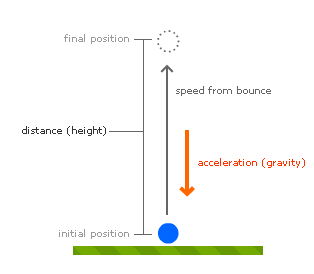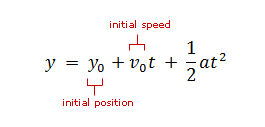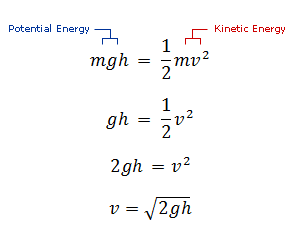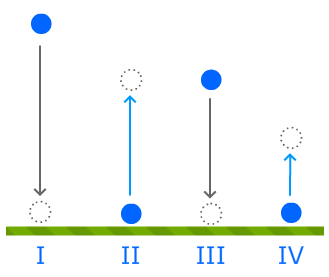|
by
kirupa | 10 February 2009
In the
previous page, you saw the animation that I will be
deconstructing, and you also received an overview of the
math behind falling objects. In this page, let's pick up
from where we left off and look at the math behind objects
that bounce up after hitting the ground.
Our ball's movement is actually made up of two separate
sequences. The first is the falling sequence which I
described above. The second is the rising sequence, the
bounce, and let's look at that now.
When your ball hits the ground and bounces, the following
diagram describes what is at play on the way up:

Before, gravity was your friend. It helped move your ball
in the correct direction. Now, though, gravity is actually
fighting against you. You have the upward initial speed from
your bounce competing with the downward pressure of gravity.
Fortunately, the equation I showed you above is flexible
enough to work in this situation as well:

This time, we don't get rid of the initial speed portion
of the equation. Instead, we actually have an initial speed.
This initial speed is the final speed of the ball as it fell
earlier. How do we calculate the final speed of the ball as
it hits the ground? This requires another equation, and this
comes from the series of equations linking Kinetic Energy
and Potential Energy:

The speed of an object under constant acceleration is the
square root of two times gravity (aka acceleration) and
height. This result makes up the initial speed, and you can
plug this value into the
equation that is shown just a few paragraphs ago.
Putting these two equations together, you have everything
you need for defining the bounce. There is a slight catch
though, so let's look at that next.
One thing you need to keep in mind is
conservation of energy. In an ideal world, a ball you drop
from a certain height will keep bouncing back to that exact
height every time. In other words, your ball will be
bouncing forever. This is clearly not the case in the real
world. The reason is that, each time the ball hits the
ground, some of the energy from the impact is converted into
other things such as heat and sound. Not everything goes
back into making the ball bounce.
With each subsequent bounce, your ball has a bit less
energy than it did in the bounce that preceded it. That is
the real world. Flash
simulates an ideal world. What you will need to do is force
some energy decay to cause your ball to not bounce
indefinitely. There are numerous areas where you can do
that, but the one that I will interfere with is the initial
speed as you are about to bounce up:

Each time the ball is about to bounce up (stages II and
IV), I decay the value of the initial speed by a certain
amount. This gives you the effect of your ball bouncing with
each subsequent bounce being weaker than the one that
preceded it. In the physical world, the amount of energy
your ball has with each bounce is decreased when it hits the
ground. This decay indirectly gives us the same effect in an
ideal world. That is all there is to the physics behind all
of this.
Ok, now that you have a primer on how a ball's bounce
theoretically works,
let's look at the code and see how the world of physics maps
with how we do things in Flash.
Onwards to the
next page!
|